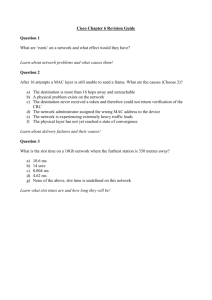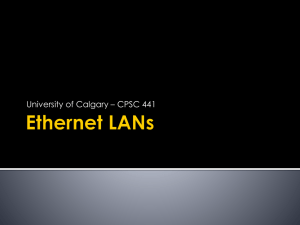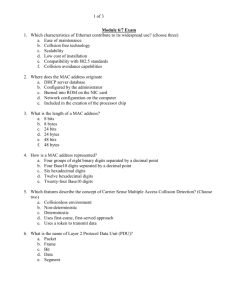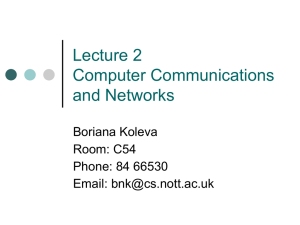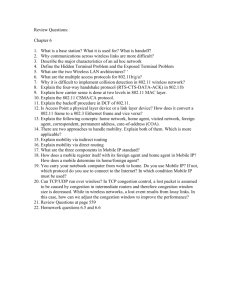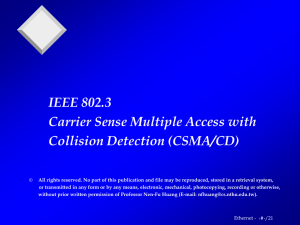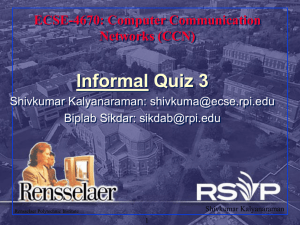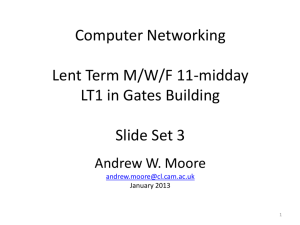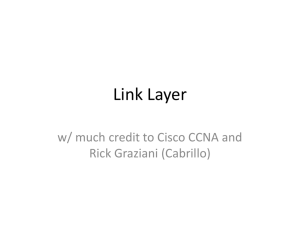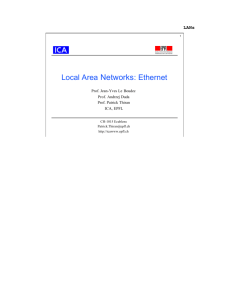Document
advertisement
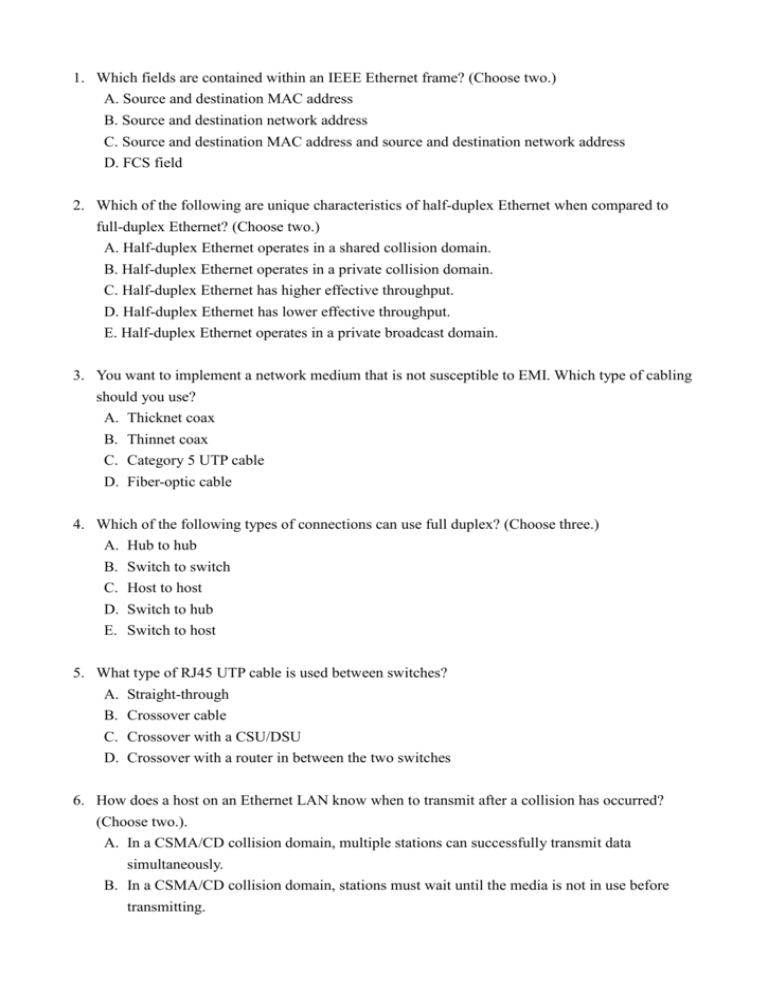
1. Which fields are contained within an IEEE Ethernet frame? (Choose two.) A. Source and destination MAC address B. Source and destination network address C. Source and destination MAC address and source and destination network address D. FCS field 2. Which of the following are unique characteristics of half-duplex Ethernet when compared to full-duplex Ethernet? (Choose two.) A. Half-duplex Ethernet operates in a shared collision domain. B. Half-duplex Ethernet operates in a private collision domain. C. Half-duplex Ethernet has higher effective throughput. D. Half-duplex Ethernet has lower effective throughput. E. Half-duplex Ethernet operates in a private broadcast domain. 3. You want to implement a network medium that is not susceptible to EMI. Which type of cabling should you use? A. Thicknet coax B. Thinnet coax C. Category 5 UTP cable D. Fiber-optic cable 4. Which of the following types of connections can use full duplex? (Choose three.) A. Hub to hub B. Switch to switch C. Host to host D. Switch to hub E. Switch to host 5. What type of RJ45 UTP cable is used between switches? A. Straight-through B. Crossover cable C. Crossover with a CSU/DSU D. Crossover with a router in between the two switches 6. How does a host on an Ethernet LAN know when to transmit after a collision has occurred? (Choose two.). A. In a CSMA/CD collision domain, multiple stations can successfully transmit data simultaneously. B. In a CSMA/CD collision domain, stations must wait until the media is not in use before transmitting. C. You can improve the CSMA/CD network by adding more hubs. D. After a collision, the station that detected the collision has first priority to resend the lost data. E. After a collision, all stations run a random backoff algorithm. When the backoff delay period has expired, all stations have equal priority to transmit data. F. After a collision, all stations involved run an identical backoff algorithm and then synchronize with each other prior to transmitting data. 7. What type of RJ45 UTP cable do you use to connect a PC’s COM port to a router or switch console port? A. Straight-through B. Crossover cabl C. Crossover with a CSU/DS D. Rolled 8. You have the following binary number: 10110111. What are the decimal and hexadecimal equivalents? A. 69/0x2102 B. 183/B7 C. 173/A6 D. 83/0xC5 9. Which of the following contention mechanisms is used by Ethernet? A. Token passing B. CSMA/CD C. CSMA/CA D. Host polling 10. In the operation of CSMA/CD, which host(s) have priority after the expiration of the backoff algorithm? A. All hosts have equal priority. B. The two hosts that caused the collision will have equal priority. C. The host that sent the jam signal after the collision. D. The host with the highest MAC address. 11. Which of the following is correct? A. Full-duplex Ethernet uses one pair of wires. B. Full-duplex Ethernet uses two pairs of wires. C. Half-duplex Ethernet uses two pairs of wires. D. Full-duplex Ethernet uses three pairs of wires. 12. Which of the following statements is false with respect to full duplex? A. B. C. D. There are no collisions in full-duplex mode. A dedicated switch port is required for each full-duplex node. There are few collisions in full-duplex mode. The host network card and the switch port must be capable of operating in full-duplex mode. 13. Which statement is correct with regard to a MAC address? A. A MAC, or logical, address is a 48-bit (6-byte) address written in a hexadecimal format. B. A MAC, or hardware, address is a 64-bit (6-byte) address written in a hexadecimal format. C. A MAC, or hardware, address is a 48-bit (6-byte) address written in a binary format. D. A MAC, or hardware, address is a 48-bit (6-byte) address written in a hexadecimal format. 14. Which part of a MAC address is called the organizationally unique identifier (OUI)? A. The first 24 bits, or 3 bytes B. The first 12 bits, or 3 bytes C. The first 24 bits, or 6 bytes D. The first 32 bits, or 3 bytes 15. Which layer of the OSI model is responsible for combining bits into bytes and bytes into frames? A. Presentation B. Data Link C. Application D. Transport 16. What is the specific term for the unwanted signal interference from adjacent pairs in the cable? A. EMI B. RFI C. Crosstalk D. Attenuation 17. Which of the following is part of the IEEE 802.3u standard? A. 100Base2 B. 10Base5 C. 100Base-TX D. 1000Base-T 18. 10GBase-Long Wavelength is known as which IEEE standard? A. 802.3F B. 802.3z C. 802.3ab D. 802.3a 19. 1000Base-T is which IEEE standard? A. 802.3F B. 802.3z C. 802.3ab D. 802.3ae 20. When making a HyperTerminal connection, what must the bit rate be set to? A. 2400bps B. 1200bps C. 9600bps D. 6400bps
